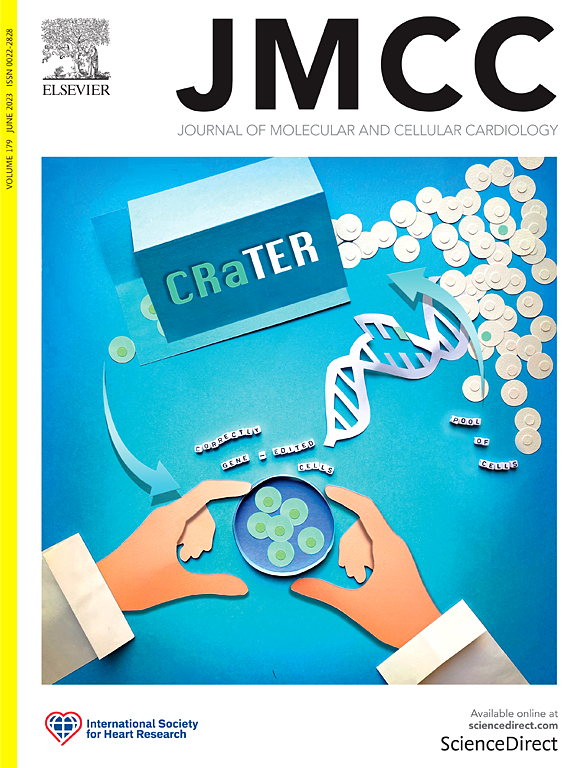Sox7缺乏通过异常瓣膜重构导致先天性主动脉狭窄。
IF 4.7
2区 医学
Q1 CARDIAC & CARDIOVASCULAR SYSTEMS
引用次数: 0
摘要
瓣膜发育异常是最常见的先天性心脏畸形。转录因子 Sox7 在血管和心脏隔膜的发育过程中起着至关重要的作用。然而,目前仍不清楚心脏瓣膜的发育是否需要Sox7。根据我们的超声心动图数据和多重染色结果,小鼠心内膜细胞特异性缺失Sox7(Nfatc1 Cre;Sox7fl/fl)会导致先天性主动脉瓣狭窄。从机制上讲,Sox7 通过调节 MMP9 影响瓣膜细胞外基质(ECM)的重塑。同时,Sox7 还影响其他瓣膜重塑过程,包括 Sox7 缺乏小鼠瓣膜细胞的凋亡和增殖。同样,在瓣膜间质细胞(VICs)中,Sox7过表达会增加裂解caspase3和TUNEL阳性VICs的蛋白水平,而Ki67阳性VICs则会减少。在缺乏 Sox7 的 VIC 中则观察到相反的趋势。在 Sox7 过表达组中观察到 Rbm25 转录水平显著提高,而 Osterix、Osteopontin 和 Runx2 等钙化标志物的 mRNA 和蛋白水平降低。而在Sox7缺乏的VIC中则观察到相反的趋势。Von Kossa染色和茜素红染色也证明了Nfatc1 Cre;Sox7fl/fl小鼠的严重钙化。此外,我们还在主动脉瓣狭窄患者的胎儿主动脉瓣中检测到了 Sox7 蛋白表达,其中 Sox7 阳性的间充质细胞减少。综上所述,这些发现确定了 Sox7 是导致人类先天性主动脉瓣狭窄的潜在致病基因。我们的研究为先天性瓣膜畸形的诊断和治疗提供了新的策略。本文章由计算机程序翻译,如有差异,请以英文原文为准。

Deficiency of Sox7 leads to congenital aortic stenosis via abnormal valve remodeling
Abnormal valve development is the most common congenital heart malformation. The transcription factor Sox7 plays a critical role in the development of vascular and cardiac septation. However, it remains unclear whether Sox7 is required for heart valve development. In the present study, Sox7 was strongly expressed in the endocardial and mesenchymal cells of the developing aortic valve in mice and humans, and that endocardial cell specific deletion of Sox7 (Nfatc1 Cre;Sox7fl/fl) in mice leads to congenital aortic stenosis basing on our echocardiography data and multiple staining results. Mechanistically, Sox7 influences extracellular matrix (ECM) remodeling of the valve through regulating MMP9. Meanwhile, Sox7 also affects other valvular remodeling processes, including apoptosis and proliferation of valvular cells in Sox7 deficiency mice. Similarly, in valvular interstitial cells (VICs), Sox7 overexpression increased the protein levels of cleaved caspase3 and TUNEL-positive VICs, while Ki67-positive VICs decreased. The reverse trend was observed in VICs with Sox7 deficiency. Significant enhancement of Rbm25 transcriptional levels was observed in the Sox7 overexpression group, and the mRNA and protein levels of calcification markers such as Osterix, Osteopontin and Runx2 were reduced. The reverse trend was observed in VICs with Sox7 deficiency. Von Kossa staining and Alizarin Red staining also demonstrated that sever calcification in Nfatc1 Cre;Sox7fl/fl mice. Moreover, we detected the Sox7 protein expression in human fetal aortic valves in patients with aortic stenosis, in which Sox7 positive mesenchymal cells were decreased. Taken together, these findings identify Sox7 as a potential pathogenic gene responsible for congenital aortic stenosis in human. Our study provides novel strategies for the diagnosis and treatment of congenital valvular malformation.
求助全文
通过发布文献求助,成功后即可免费获取论文全文。
去求助
来源期刊
CiteScore
10.70
自引率
0.00%
发文量
171
审稿时长
42 days
期刊介绍:
The Journal of Molecular and Cellular Cardiology publishes work advancing knowledge of the mechanisms responsible for both normal and diseased cardiovascular function. To this end papers are published in all relevant areas. These include (but are not limited to): structural biology; genetics; proteomics; morphology; stem cells; molecular biology; metabolism; biophysics; bioengineering; computational modeling and systems analysis; electrophysiology; pharmacology and physiology. Papers are encouraged with both basic and translational approaches. The journal is directed not only to basic scientists but also to clinical cardiologists who wish to follow the rapidly advancing frontiers of basic knowledge of the heart and circulation.

 求助内容:
求助内容: 应助结果提醒方式:
应助结果提醒方式:


